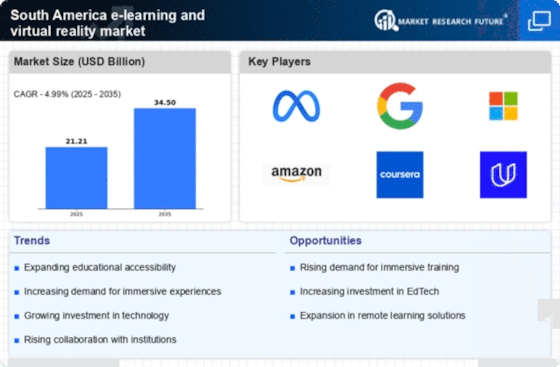Technological Advancements in VR
the e-learning-virtual reality market is experiencing a surge due to rapid technological advancements in virtual reality (VR) hardware and software. Enhanced graphics, improved processing power, and more affordable VR devices are making immersive learning experiences more accessible. For instance, the introduction of standalone VR headsets has reduced the barriers to entry for educational institutions. As of 2025, the market for VR devices in education is projected to reach approximately $1.5 billion in South America, indicating a robust growth trajectory. This technological evolution not only enriches the learning experience but also encourages institutions to integrate VR into their curricula, thereby driving demand in the e learning-virtual-reality market.
Increased Focus on STEM Education
The emphasis on Science, Technology, Engineering, and Mathematics (STEM) education is significantly impacting the e-learning-virtual reality market. Educational institutions are increasingly incorporating VR into STEM curricula to provide students with hands-on, immersive experiences that enhance understanding of complex concepts. Countries like Colombia are leading initiatives to integrate VR into STEM education, with a projected increase of 40% in VR-based STEM programs by 2027. This focus on STEM not only prepares students for future careers but also drives demand for VR content and applications, thereby fostering growth in the e learning-virtual-reality market. The alignment of VR technology with educational goals in STEM fields is likely to create new opportunities for developers and educators alike.
Government Initiatives and Funding
Government initiatives aimed at enhancing educational outcomes are significantly influencing the e-learning-virtual reality market. Various countries in the region are allocating funds to promote digital education and technology integration in schools. For example, Brazil's Ministry of Education has launched programs to support the adoption of innovative teaching methods, including VR. Such initiatives are expected to increase the penetration of VR in educational settings, with an estimated growth rate of 25% in government-funded VR projects by 2026. This financial backing not only facilitates the development of VR content but also encourages educational institutions to invest in immersive learning technologies, thereby propelling the e learning-virtual-reality market forward.
Growing Interest in Lifelong Learning
the e-learning-virtual reality market is benefiting from a growing interest in lifelong learning among adults. As the workforce evolves, professionals are seeking continuous education and skill enhancement, leading to increased demand for innovative learning solutions. VR offers unique opportunities for adult learners to engage in immersive training experiences that can be applied in real-world scenarios. In Brazil, for instance, the market for VR-based professional development is expected to grow by 35% over the next few years. This trend indicates a shift towards more engaging and effective training methods, which could potentially reshape the landscape of adult education in the region. The focus on lifelong learning is likely to drive further investment in the e learning-virtual-reality market.
Rising Demand for Personalized Learning
the e-learning-virtual reality market is witnessing a growing demand for personalized learning experiences. As educational institutions strive to cater to diverse learning styles and paces, VR technology offers tailored educational solutions that can adapt to individual needs. This trend is particularly evident in countries like Argentina and Chile, where educators are increasingly utilizing VR to create customized learning environments. The market for personalized VR learning solutions is projected to grow by 30% annually, reflecting a shift towards more individualized educational approaches. This demand for personalization is likely to drive innovation and investment in the e learning-virtual-reality market, as stakeholders seek to enhance student engagement and learning outcomes.


















Leave a Comment